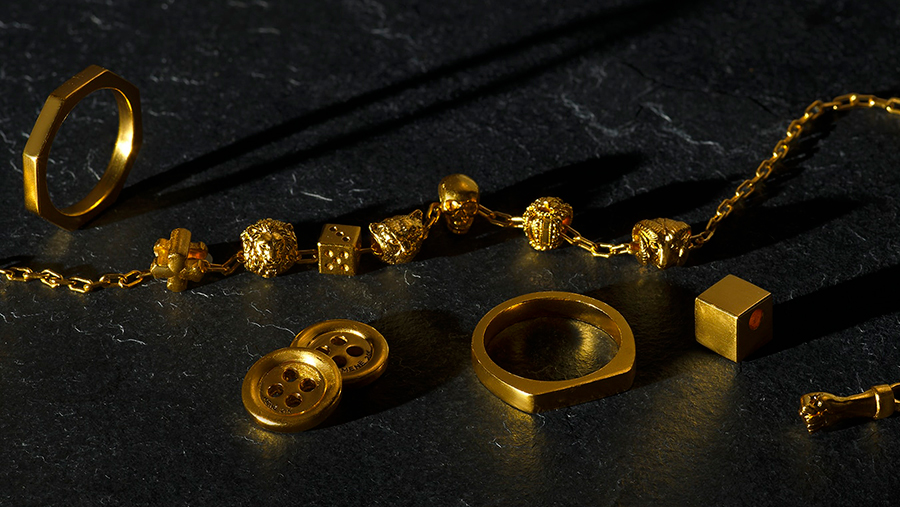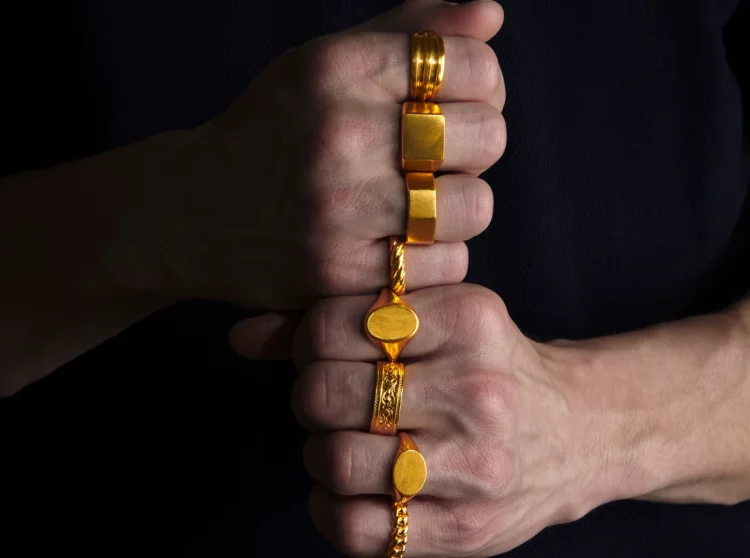Gold jewelry has long been admired not only for its beauty but also for its potential as an investment. While traditional gold investments, such as bullion and gold-backed exchange-traded funds (ETFs), are well-known, many investors are beginning to realize that gold jewelry, particularly high-quality, collectible pieces, can also offer a promising return on investment. But how can investors select the right gold jewelry to maximize their gains? This article will explore how to select investment-grade gold jewelry, the key differences between bullion gold and jewelry investments, trends in the collectible gold jewelry market, and practical tips for investing in high-quality gold jewelry pieces.
How to Select Investment-Grade Gold Jewelry
Investment-grade gold jewelry is not just about the amount of gold it contains, but also its design, craftsmanship, rarity, and historical significance. When considering jewelry as an investment, it’s important to look beyond just the weight of the metal and consider the following factors:
1. Purity and Weight of Gold: The first and most obvious factor to consider when selecting gold jewelry as an investment is the purity of the metal. The higher the gold content, the more valuable the piece will be. Pure gold, often referred to as 24-karat (24K) gold, is 99.9% pure, but other common purities include 22K, 18K, and 14K gold. Jewelry made from 18K or 22K gold, while still valuable, contains other metals mixed with the gold, which can affect its resale value.
In addition to purity, the weight of the jewelry also matters. Gold jewelry is often priced per gram or ounce, so the heavier the piece, the more valuable it will be. However, it’s important to consider whether the design adds artistic value to the piece beyond just the raw gold content.
2. Craftsmanship and Design: Jewelry that is well-crafted by renowned designers or skilled artisans tends to appreciate in value more than mass-produced pieces. Unique designs, intricate workmanship, and high-quality gemstones can all add significant value to a piece of jewelry. In some cases, the artistry and historical significance of the design may even make the jewelry more valuable than its gold content.
Famous designers such as Cartier, Van Cleef & Arpels, and Tiffany & Co. produce jewelry that is highly sought after by collectors and investors alike. These pieces often have a higher resale value due to their brand recognition and the enduring appeal of their design.
3. Rarity and Historical Significance: The rarity of a piece plays a crucial role in determining its investment potential. Vintage and antique jewelry from famous houses or periods of history can command significantly higher prices than newer pieces. For example, jewelry from the Art Deco period or pieces with historical significance, such as those worn by famous personalities, often fetch high prices at auction.
Limited-edition collections or one-of-a-kind pieces can also increase the investment value. Jewelry that is tied to important cultural events or milestones can be especially valuable to collectors.
Understanding the Difference Between Bullion Gold and Jewelry Investments
While both bullion gold and jewelry can serve as a store of wealth, there are key differences between the two when it comes to investing. Let’s break them down:
1. Bullion Gold: Bullion gold refers to gold that is bought and sold primarily for its metal content rather than its artistic or aesthetic value. This includes gold bars, coins, and ingots, which are typically 99.9% pure gold. Bullion is a straightforward investment, as the value is determined by the current market price of gold, and the amount of gold in the item.
The main advantage of investing in bullion is its liquidity. Gold bullion is easy to buy and sell in standard weights, and its value is transparent. However, bullion does not have the added benefit of design or craftsmanship that can enhance its value over time.
2. Jewelry Investments: Unlike bullion, gold jewelry investments are not solely based on the weight and purity of the metal. Jewelry investments involve the value of the piece as a whole, including factors like artistry, craftsmanship, historical significance, and brand recognition. Jewelry can offer greater potential for appreciation in value, especially for rare, high-quality pieces, because it combines the inherent value of the gold with other factors that are harder to quantify.

However, jewelry can be harder to liquidate quickly compared to bullion, as finding the right buyer for a unique or high-end piece may take longer. Jewelry also carries additional costs in terms of design, brand premiums, and maintenance.
3. Price Volatility: Gold bullion tends to track the price of gold more closely and may fluctuate more in response to market conditions like inflation, economic stability, or geopolitical events. Jewelry, on the other hand, can experience more price fluctuations based on fashion trends, brand value, and the rarity of specific designs. A piece of jewelry might hold its value better in a market driven by luxury goods and collectibles, but it can also see its value decrease if demand for a particular design or designer wanes.
Trends in the Collectible Gold Jewelry Market
The gold jewelry market has evolved significantly in recent years, and investors should be aware of the key trends that are influencing the value of collectible gold jewelry.
1. Vintage and Antique Jewelry: There is a growing trend of interest in vintage and antique gold jewelry, particularly from renowned designers and specific historical periods. Collectors are increasingly seeking out pieces from the Art Deco, Victorian, and Edwardian periods, as well as mid-century modern designs. The unique styles, craftsmanship, and historical significance of these pieces make them highly desirable, and their value tends to appreciate over time.
2. The Rise of Ethical and Eco-Friendly Jewelry: As consumers become more environmentally conscious, ethical and eco-friendly gold jewelry is gaining popularity. Jewelry made from recycled gold or ethically sourced materials is in high demand, particularly among buyers who are interested in sustainability. Investment-grade gold jewelry that emphasizes ethical sourcing is likely to see a rise in value, as it appeals to a growing market of conscientious buyers.
3. Custom and Artisanal Jewelry: Custom-made and artisanal jewelry are increasingly becoming sought-after in the investment space. Pieces that feature unique designs or showcase the work of skilled artisans tend to hold more appeal than mass-produced items. Artisanal jewelry, especially that which uses high-quality gemstones or hand-crafted techniques, often carries a premium price tag and can appreciate in value over time.
4. The Influence of Luxury Brands: Gold jewelry from established luxury brands such as Chanel, Gucci, and Bulgari has long been a staple in the high-end jewelry market. As these brands continue to release new collections and limited-edition pieces, the value of their gold jewelry often increases due to brand recognition and exclusivity. Investing in pieces from these renowned brands can provide investors with both aesthetic pleasure and potential for appreciation in value.
Tips for Investing in High-Quality Gold Jewelry Pieces
Investing in gold jewelry requires more than just picking out attractive pieces—it involves careful planning, research, and an understanding of the market. Here are some tips for investors looking to build a high-quality gold jewelry portfolio:
1. Focus on Quality Over Quantity: Instead of buying numerous pieces with low value, focus on acquiring fewer but higher-quality pieces. Look for well-crafted designs from renowned brands or highly skilled artisans, and consider pieces with historical significance or unique craftsmanship.
2. Keep Track of Market Trends: Gold jewelry is influenced by various market trends, including fashion, celebrity endorsements, and global events. Keep an eye on emerging trends, and be aware of shifts in consumer preferences for vintage, ethical, or custom jewelry. Knowing what’s in demand can help you make better investment decisions.
3. Consider the Brand and Designer: Brand recognition can play a significant role in the value of a piece. Jewelry from prestigious designers or luxury brands tends to appreciate more reliably than generic pieces. Look for jewelry from iconic designers, established brands, or exclusive collections to increase the potential for high returns.
4. Work with a Trusted Dealer: Whether you’re buying new or vintage gold jewelry, work with reputable dealers who can provide verification of authenticity, provenance, and condition. A trusted dealer will also help guide you in selecting pieces that have long-term investment potential.
5. Diversify Your Jewelry Portfolio: Just like any investment portfolio, diversify your jewelry holdings. Invest in different styles, eras, and types of gold jewelry to reduce risk. While vintage pieces can provide significant returns, don’t overlook contemporary designs that might appreciate in value over time.
Conclusion
Gold jewelry can be a valuable and rewarding investment, but success requires careful selection, a keen understanding of the market, and a focus on high-quality, unique pieces. By considering factors such as purity, craftsmanship, rarity, and historical significance, investors can make informed decisions that will yield long-term returns. Understanding the difference between bullion gold and jewelry investments, keeping up with trends in the collectible gold jewelry market, and following key investment strategies can help you navigate the world of gold jewelry as a profitable investment.
































